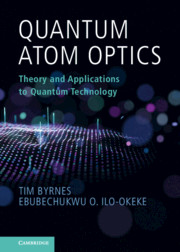Book contents
- Frontmatter
- Dedication
- Contents
- Foreword
- Preface
- 1 Quantum Many-Body Systems
- 2 Bose–Einstein Condensation
- 3 The Order Parameter and Gross–Pitaevskii Equation
- 4 Spin Dynamics of Atoms
- 5 Spinor Bose–Einstein Condensates
- 6 Diffraction of Atoms Using Standing Wave Light
- 7 Atom Interferometry
- 8 Atom Interferometry Beyond the Standard Quantum Limit
- 9 Quantum Simulation
- 10 Entanglement Between Atom Ensembles
- 11 Quantum Information Processing with Atomic Ensembles
- References
- Index
9 - Quantum Simulation
Published online by Cambridge University Press: 23 July 2021
- Frontmatter
- Dedication
- Contents
- Foreword
- Preface
- 1 Quantum Many-Body Systems
- 2 Bose–Einstein Condensation
- 3 The Order Parameter and Gross–Pitaevskii Equation
- 4 Spin Dynamics of Atoms
- 5 Spinor Bose–Einstein Condensates
- 6 Diffraction of Atoms Using Standing Wave Light
- 7 Atom Interferometry
- 8 Atom Interferometry Beyond the Standard Quantum Limit
- 9 Quantum Simulation
- 10 Entanglement Between Atom Ensembles
- 11 Quantum Information Processing with Atomic Ensembles
- References
- Index
Summary
This chapter introduces the topic of quantum simulation and the various approaches that are being pursued in cold atom systems. We first start by describing what the aims of quantum simulation are, and why this is considered a difficult yet important problem. The example of the transverse field Ising model is discussed to illustrate the type of phenomenology, more commonly studied in condensed matter physics, that is of interest in quantum simulation. We then discuss two main approaches to quantum simulation. The first is digital quantum simulation, where a quantum computer is used to simulate the time evolution of a system, and methods to obtain static quantities is are discussed. The second is analogue quantum simulation, where experimental methods are used to physically create a tailored system in the laboratory. The toolbox of methods that is available to the cold atom physicist is explained, such aswhich includes optical lattices, Feshbach resonances, artificial gauge fields, spin-orbit coupling, time-of-flight measurements, and the quantum gas microscope are explained. We then consider a specific case study of one of the earliest quantum simulation experiments, where a Bose--Hubbard model was realized to observe a superfluid to Mott insulator transition in cold atoms.
Keywords
- Type
- Chapter
- Information
- Quantum Atom OpticsTheory and Applications to Quantum Technology, pp. 152 - 174Publisher: Cambridge University PressPrint publication year: 2021

